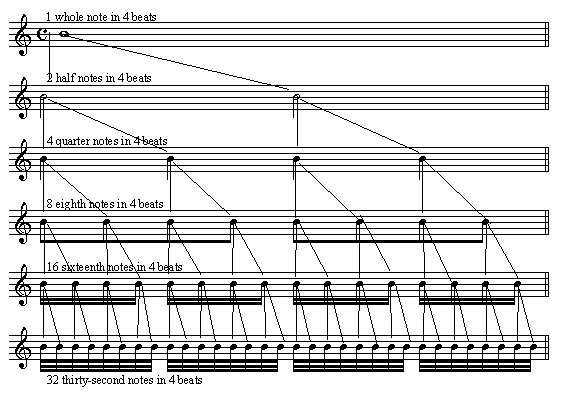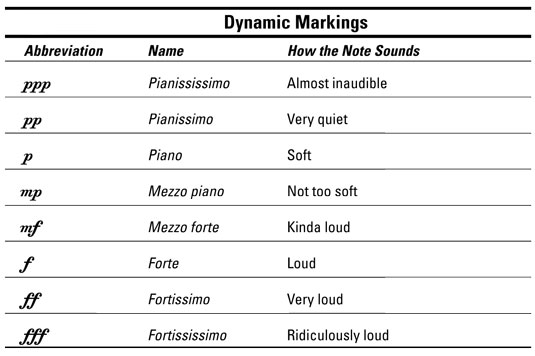Based on the given values of each note, we can then arrived to a diagram such as this
The Tie
- it is a curved line that connects two same pitches and connects their sound with a duration equal to the sum of the two note values
The Slur
- is a curved line that connects two or more notes of different pitches.
The Dot
- when place to the right of a note head, the dot lengthens the value of the note by half against its value. When another dot is added, the dot lengthens the value of the first dot by half its value.
Dots can also be placed after rest, the same concept applies, the only diffirence is you are now dealing with rests.
Irregular Subdivisions
- as shown above by our rhythm notation chart, a note can be divided and subdivided into equal parts. Those divisions that require added numbers are called irregular divisions and subdivisions.
Rhythm
- is a general term used to described the movement or motion of music in time. Its fundamental unit is
beat or
pulse. Even people who are not trained in music can sense the pulse or beat and may respond either by tapping their foot or clapping their hand.
Tempo
- is an Italian word that comes from the greek word
tempus which means
time.
Here are the most common tempos, from slowest to fastest.
TEMPO NAME BEATS PER MINUTE
Largo 40-60
Larghetto 60-66
Adagio 66-76
Andante 76-108
Moderato 108-120
Allegro 120-168
Presto 168-200
Prestissimo 200-208
Tempo Related Terms
There are terms that affect the tempo of a piece aside from the ones mentioned above.
accelerando (accel.) = speed up gradually
allargando (allarg.) = slow down and grow louder
ritardando (rit.) = slow down gradually
rallentando (rall.) = slow down gradually
Meter or Time Signatures
- defined as a regular, recurring pattern of strong and weak beats. A meter or time signature is made up of two numbers. It appears at the beginning of a piece. It gives us two different informations. The number above indicates the number of basic note values, it may not indicate the number of pulses per measure as we will see later.
- the number below indicates a basic note value; 2 stands for a half note, 4 stands for a quarter note, 8 stands for an eight note, 16 stands for a sixteenth note and 32 stands for a 32nd note.
Simple Meter
- each beat is divided into two parts (simple subdivision). In a simple meter, the upper numbers are usually 2,3 or 4 indicating two, three or four basic pulses.
The basic pulse in a simple meter will be some kind of a note whose value is not dotted.
Compound Meter
- in a compound meter, each pulse is a dotted note, which we will divide into groups of three parts (compound division). The upper numbers you usually see in a compound meter is 6, 9 and 12. In compound meter, the lower number refers to the division of the beat while the number above indicates the number of these division per measure.
The basic pulse of a compound meter is some kind of a dotted note value.
Duple, Triple and Quadruple Meters
- both simple and compound meter will have two, three or four recurring pulses. Meters are identified as duple if there are two basic pulses, triple if there are three basic pulses and quadruple if there are four. Theses designations are often combined with the division names to discribe a meter.
Assymetrical Meters
- these are meter that cannot be divided into equal groups of 2, 3 or 4. The upper number of these meters are usually 5 or 7.
Syncopation
- if the part of the measure that is not usually accented is given emphasis, that is called a syncopation.
- another way of defining it to simply stress the beat that is usually unstressed.
Watch these videos to see and hear a sample of syncopated music


















